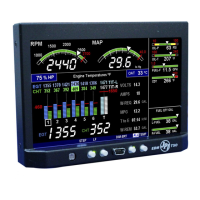Page 34 Engine Data Management
Expanded Leaning Procedures
Lean Of Peak, LOP mode: During the ‘lean of peak’ process, the EDM
hunts for the last cylinder to peak. Ultimately, you want to have ALL
cylinders operating on the lean side of peak. You will final adjust your
mixture to this cylinder. To provide a unique graphical depiction during
lean of peak operation, the columns become inverted after the first EGT
goes just beyond peak. Each EGT column then originates from the top of
the display and drops downward. As each subsequent EGT goes past
peak, its column will begin falling. The columns length depicts how far the
EGT has dropped below its original peak. In this mode, each segment is
5° F. You will continue to lean until the last EGT peaks (note: never lean
to the point where the engine is running rough). When the last EGT
peaks, its column will flash and RICHEST appears. The digital readout
will show the current temperature difference from where peak EGT
occurred and the current fuel flow (if so equipped). Note: holding the
PEAK button will show the captured peak value of the ‘last EGT to peak’
and also the difference in fuel flow between the first and last to peak
(known as the GAMI Spread). This is a good indication of injector
balance (the smaller the FF difference, the better the balance). Tapping
STEP exits the lean find mode and automatic scanning resumes.
Leaning Turbocharged Engines: The leaning process for turbocharged
engines is by reference to the first EGT or TIT to reach peak. Therefore
you should use the Rich Of Peak mode. The factory TIT red line (typically
1650°F to 1750°F) may limit the leaning process, depending on flight
conditions. If TIT exceeds red line (but not by more than 99°), the EDM
will allow you to continue leaning for one minute before a TIT alarm
activates. NOTE: TIT can read approximately 100°F hotter than the
hottest EGT due to unburned fuel in the exhaust igniting and is not
necessarily abnormal behavior. The reduced size of the JPI Hastaloy-X-
tip probes produce faster response and are more accurate than the
massive factory installed probes. Therefore a JPI probe may read as
much as 100°F higher than a factory installed probe.

